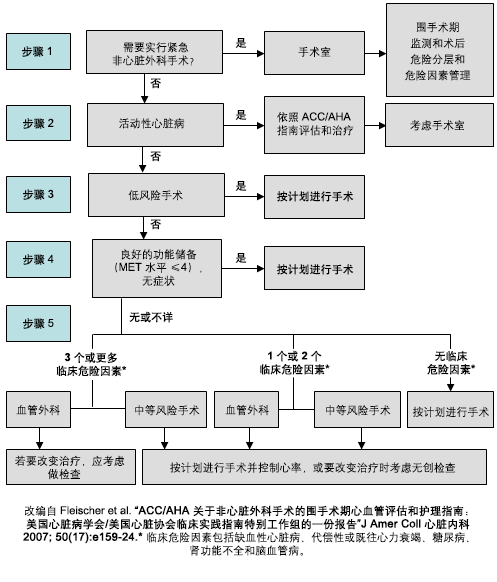在美国,每年约有 2700 万患者接受非心脏外科手术。[1]Gregoratos G. Current guideline-based preoperative evaluation provides the best management of patients undergoing noncardiac surgery. Circulation. 2008;117:3134-3144.http://circ.ahajournals.org/content/117/24/3134.full.pdf+htmlhttp://www.ncbi.nlm.nih.gov/pubmed/18559713?tool=bestpractice.com 其中约 5 万患者存在围手术期心肌梗死 (myocardialinfarction, MI)。而且,每年 4 万例围手术期死亡病例中,超过一半由心脏事件导致。[2]National Center for Health Statistics. Vital statistics of the United States: 1988, 3. DHHS pub no (PHS) 89-1232. Washington, DC: NCHS US Public Health Services; 1989:10-17,66,67,100,101. 年龄>65岁的患者发生心脏疾病、心脏并发症和死亡的风险更高。考虑到在未来数十年间这一患者人群的数量将大幅增加,可以预见的是,在全球范围内,行非心脏手术且存在较高围手术期心脏风险的患者数量将显著增加。
阅读更多大多数围手术期心脏并发症和心源性死亡与 MI、心力衰竭或心律失常有关。因此,术前评估和围手术期管理应侧重于对相应患者针对冠心病 (coronary artery disease, CAD)、左心室 (left ventricular, LV) 收缩功能不全和严重心律失常进行检测、特征识别和治疗。这些患者包括已确诊或疑诊 CAD、心律失常、有心力衰竭病史或存在相应症状的患者。对于年龄≥50 岁的患者,需要采集更详细的病史,并进行更详尽的体格检查。
个体术前心脏风险评估的目的包括:[3]Kristensen SD, Knuuti J, Saraste A, et al. 2014 ESC/ESA guidelines on non-cardiac surgery: cardiovascular assessment and management: The Joint Task Force on non-cardiac surgery: cardiovascular assessment and management of the European Society of Cardiology (ESC) and the European Society of Anaesthesiology (ESA). Eur Heart J. 2014;35:2383-2431.http://eurheartj.oxfordjournals.org/content/ehj/35/35/2383.full.pdfhttp://www.ncbi.nlm.nih.gov/pubmed/25086026?tool=bestpractice.com[4]Fleisher LA, Fleischmann KE, Auerbach AD, et al. 2014 ACC/AHA guideline on perioperative cardiovascular evaluation and management of patients undergoing noncardiac surgery: a report of the American College of Cardiology/American Heart Association Task Force on practice guidelines. J Am Coll Cardiol. 2014;64:e77-e137.http://circ.ahajournals.org/content/130/24/e278.full.pdf+htmlhttp://www.ncbi.nlm.nih.gov/pubmed/25091544?tool=bestpractice.com[5]Anderson JL, Antman EM, Harold JG, et al. Clinical practice guidelines on perioperative cardiovascular evaluation: collaborative efforts among the collaborative efforts among the ACC, AHA, and ESC. Circulation. 2014;130:2213-2214.http://circ.ahajournals.org/content/130/24/2213http://www.ncbi.nlm.nih.gov/pubmed/25085963?tool=bestpractice.com
评估的主要目标是:
评估性质应个体化,需要根据患者和特定临床情境决定。


